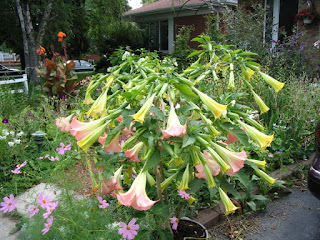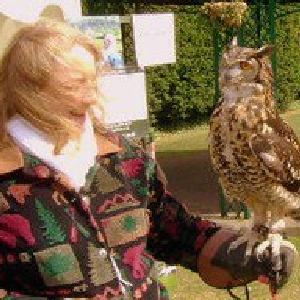The Best Weed Field Guide for the West I've Seen
I just discovered the best field guide I've ever seen for identifying weeds here in California. I'll finally be able to properly name all those I find and photograph while out walking and on my own property. The book was sitting on the shelf at my local public library. At almost an inch and a half thick, Weeds of the West includes almost every weed I've seen in my area. It's published by the Western Society of Weed Science. Its seven authors all have advanced degrees and specialize in weeds. I'm reviewing the 5th Edition published in 1996, but there are later editions I haven't yet seen.
 |
| Wild Cucumber with Grasses and Mustard, Photo © B. Radisavljevic |
What I Love about This Reference Book
It's more like what's not to love? The picture quality is excellent. The arrangement of listings is logical. The descriptions provide all the information farmers, campers, gardeners, or hikers need to identify the weeds they encounter. Finally, the pages at the back make everything easier to find and understand.
The Photographs
Poison HemlockThere are three photographs for each plant listed. Let's look first at the poison hemlock plant listed on pages 22-23 in the 5th edition of Weeds of the West. It's a weed found almost everywhere in San Luis Obispo County that's not cultivated. Each listing has three images like this.
 |
| My scan of pages 22-23 in the 5th edition of Weeds of the West (Western Society of Weed Science) |
In Roadside Plants of California, Thomas Belzer has given poison hemlock a playing-card size color photo of the top of one flowering stem. It has a good shot of the flowers and a couple of leaves, but the descriptive paragraph doesn't even mention the purple spots. It does mention that Wild Celery is a near look-alike that is not poisonous. Weeds of the West does not mention that.
The Sunset Western Garden Problem Solver's photos of poison hemlock are so small they are almost useless. You get an overall idea of what one section of leaves and flowers looks like, but no view of the entire plant or its surroundings. You have to rely on the written description of the purple spots because the inset photo is only an oval of 1" x 1½." It's a good book as far as it goes, but it's purpose is more to help gardeners identify the weeds so they can manage them.
The large full-page photo in Weeds of the West shows as much of an overview as possible, and if a plant is too tall for a photo to hold it all, you will see as much of it as possible for identifying its form. The two smaller photos on the opposite page under the description zero in on the two most important plant characteristics for identifying it. For poison hemlock you see the purple stem and a leaf. For western waterhemlock the smaller photos are a branch with leaves and a split distinctive root, its most poisonous part.
Matt Ritter in California Plants and Plants of San Luis Obispo County has photos with the same high quality, but the book lacks the overview shot. The book also has fewer plants included than Weeds of the West, since it's more specialized. See Review of California Plant Field Guides by Matt Ritter for a more thorough review of his field guides.
Jointed Goatgrass
When I work in my garden, it seems the weeds that bother me the most are the grassy weeds. So far I've had only the Ritter books and the Sunset Western Garden Problem Solver to help me identify these pests, and they haven't helped as much as I'd hoped. But Weeds of the West identifies at least twice as many of these grassy weeds as the other books. I'll admit it covers more than just California, and that may be part of the reason why.
 |
| My scan of pages 408-409 in the 5th edition of Weeds of the West (Western Society of Weed Science) |
The Arrangement of the Listings
Weeds of the West entries are arranged by plant families. Many other books are arranged by habitat. Both arrangements are useful, but I find the arrangement by family helps me see that plants I never would have suspected are related to each other. Since related plants don't always need the same growing conditions or share a habitat, having them together in a book section make the relationships more obvious.
If you look at the tops of my scanned pages above, you will see the left page has the common name for the weed in boldface at the top. Under it is the scientific name in italics. On the page on the right we see the common name again followed by the plant family's scientific name. Under that is the common name for the plant family. I'm not surprised that poison hemlock is related to wild carrot and wild caraway. I am surprised that the bull thistle is related to the sunflower. I'm amazed at all the cousins the sunflower has.
 |
| This photo I took in my yard features the wild cucumber (also called manroot.) Weeds of the West will help me identify the wild grassy weeds that surround it. Photo © B. Radisavljevic |
The Text Descriptions
The text that accompanies the photographs in Weeds of the West provides any other information it takes to identify the plant. It points out where to look for what in the photos. It tells you where the plant is native, its size, and its growth habit -- tall and erect or prostrate and sprawling. Words describe the color and the odor of each plant part if it's a factor in identifying it..
Leaf descriptions include whether they are dull or shiny, how their edges look (smooth or sawtoothed), whether they are divided and if so how many times, how they are arranged on the stem (opposite or alternating), and anything special about how they are attached. Flowers and seeds are also thoroughly described.
The last paragraph explains where you are likely to find the plant (habitat.) It also mentions any other important information you may need to know. Is the plant poisonous to humans or animals? If it's poisonous, does it resemble closely a plant that is safe?
Handy Helps in the Back of the Book
Many listings use terms laymen may not understand. So there is a Glossary at the beginning of the back matter. Next is an easy-to-use "Key to the Families in Weeds of the West." It describes what the plant families have in common and what distinguishes them from one another. The final aid to readers is an index that includes both common and scientific names.
Used editions of this book vary in price.
Should You Buy This Book?
If you live in the American West and garden or spend a lot of time outdoors where wild plants grow, I think you would find this book a helpful addition to your home library. I take a lot of photo walks in parks and I also garden. I like to be able to identify what I photograph, and most books don't supply the information I need. This book is more complete than any of the others I have seen or have on my shelf. The print is large enough for even me to read easily, and the publisher did not skimp on the photos.
There are bound to be a few mistakes in a book this large -- 630 pages. I don't have the scientific background to judge the facts, but the authors certainly have academic credentials that indicate they know these plants well. I did find one omission quite by chance. I wanted to see if Queen Anne's Lace was listed in the book, since I hadn't seen it with others in the parsley family. It was in the index, but the name of the plant on the page I was directed to only said "Wild carrot" with Daucus carota L. under it. Nothing in the page for Wild carrot mentioned that Queen Anne's Lace was another common name for it. I had to find that out on the internet.
As soon as I can afford it I will probably buy this book. I'm interested in nature and especially in wild plants, so for me it would be worth it. I like the convenience of a handy reference book when I have a question.
Buyers should be aware that this is not exactly a field guide. It's too large and heavy to take hiking. It does, though, draw attention to parts of plants you should remember to photograph to identify at home later. I have never realized how important it is to observe how the leaves are attached to the stem, for example. If you have found other books for identifying wild plants too limited, I believe you will find this book is different. I believe it's worth buying for the presentation and completeness of the information.
As I was finishing this review I saw another book that may be even more complete. If you're interested in California weeds, you may also like Weeds of California and Other Western States (in two volumes.) I used the "Look Inside" feature on Amazon to check it out and it, too, looks like a book I'd like to own.
 | |
|
More I've Written about Common California Weeds
Poison Hemlock: Lovely and Lethal: a photo essay with original photos from my property and my nature walks.
Milk Thistle and Hemlock: The Prickly and the Poisonous: A Photo essay that shows both these common western weeds at all stages of growth so you can easily identify them.
Oak and Poison Oak in Photos: Can You Tell the Difference?: This will help you recognize poison oak during all stages of growth and in any season. Our local police department asked to use parts of this to help train their search and rescue teams.
Weeds I Love to Hate: Photos of my worst weed enemies and why I hate them
Vetch Runs Wild: Short post from my gardening blog with many photos of vetch I took while hiking
The California Weeds You Need to Pull Now! If you get them while they are young they won't cause as much trouble later.
Note: The author may receive a commission from purchases made using links found in this article. “As an Amazon Associate, Ebay (EPN) and/or Esty (Awin) Affiliate, I (we) earn from qualifying purchases.”























































